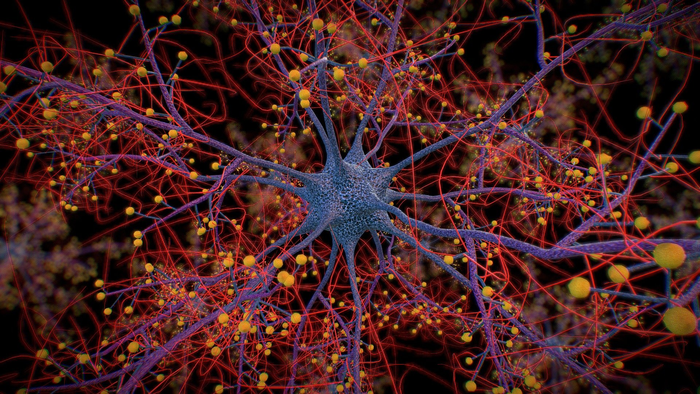The brain is inarguably the single most important organ in the human body. It controls how we move, react, think and feel, and enables us to have complex emotions and memories. The brain is composed of approximately 86 billion neurons that form a complex network. These neurons receive, process, and transfer information using chemical and electrical signals.

Credit: Image courtesy: 3dhdscan
The brain is inarguably the single most important organ in the human body. It controls how we move, react, think and feel, and enables us to have complex emotions and memories. The brain is composed of approximately 86 billion neurons that form a complex network. These neurons receive, process, and transfer information using chemical and electrical signals.
Learning how neurons respond to different signals can further the understanding of cognition and development and improve the management of disorders of the brain. But experimentally studying neuronal networks is a complex and occasionally invasive procedure. Mathematical models provide a non-invasive means to accomplish the task of understanding neuronal networks, but most current models are either too computationally intensive, or they cannot adequately simulate the different types of complex neuronal responses. In a recent study, published in Nonlinear Theory and Its Applications, IEICE, a research team led by Prof. Tohru Ikeguchi of Tokyo University of Science, has analyzed some of the complex responses of neurons in a computationally simple neuron model, the Izhikevich neuron model. “My laboratory is engaged in research on neuroscience and this study analyzes the basic mathematical properties of a neuron model. While we analyzed a single neuron model in this study, this model is often used in computational neuroscience, and not all of its properties have been clarified. Our study fills that gap,” explains Prof. Ikeguchi. The research team also comprised Mr. Yota Tsukamoto and PhD student Ms. Honami Tsushima, also from Tokyo University of Science.
The responses of a neuron to a sinusoidal input (a signal shaped like a sine wave, which oscillates smoothly and periodically) have been clarified experimentally. These responses can be either periodic, quasi-periodic, or chaotic. Previous work on the Izhikevich neuron model has demonstrated that it can simulate the periodic responses of neurons. “In this work, we analyzed the dynamical behavior of the Izhikevich neuron model in response to a sinusoidal signal and found that it exhibited not only periodic responses, but non-periodic responses as well,” explains Prof. Ikeguchi.
The research team then quantitatively analyzed how many different types of ‘inter-spike intervals’ there were in the dataset and then used it to distinguish between periodic and non-periodic responses. When a neuron receives a sufficient amount of stimulus, it emits ‘spikes,’ thereby conducting a signal to the next neuron. The inter-spike interval refers to the interval time between two consecutive spikes.
They found that neurons provided periodic responses to signals that had larger amplitudes than a certain threshold value and that signals below this value induced non-periodic responses. They also analyzed the response of the Izhikevich neuron model in detail using a technique called ‘stroboscopic observation points,’ which helped them identify that the non-periodic responses of the Izhikevich neuron model were actually quasi-periodic responses.
When asked about the future implications of this study, Prof. Ikeguchi says, “This study was limited to the model of a single neuron. In the future, we will prepare many such models and combine them to clarify how a neural network works. We will also prepare two types of neurons, excitatory and inhibitory neurons, and use them to mimic the actual brain, which will help us understand principles of information processing in our brain.”
The use of a simple model for accurate simulations of neuronal response is a significant step forward in this exciting field of research and illuminates the way towards the future understanding of cognitive and developmental disorders.
***
Reference
DOI: https://doi.org/10.1587/nolta.13.367
About The Tokyo University of Science
Tokyo University of Science (TUS) is a well-known and respected university, and the largest science-specialized private research university in Japan, with four campuses in central Tokyo and its suburbs and in Hokkaido. Established in 1881, the university has continually contributed to Japan’s development in science through inculcating the love for science in researchers, technicians, and educators.
With a mission of “Creating science and technology for the harmonious development of nature, human beings, and society”, TUS has undertaken a wide range of research from basic to applied science. TUS has embraced a multidisciplinary approach to research and undertaken intensive study in some of today’s most vital fields. TUS is a meritocracy where the best in science is recognized and nurtured. It is the only private university in Japan that has produced a Nobel Prize winner and the only private university in Asia to produce Nobel Prize winners within the natural sciences field.
Website: https://www.tus.ac.jp/en/mediarelations/
About Professor Tohru Ikeguchi from Tokyo University of Science
Tohru Ikeguchi received M.E. and Ph.D degrees from Tokyo University of Science, Japan. After working for nearly a decade as Full Professor at Saitama University, Japan, he worked at Tokyo University of Science as Full Professor at the Department of Management Science from 2014 to 2016. Since then, he has been a Full Professor at the Department of Information and Computer Technology in Tokyo University of Science. His research interests include nonlinear time series analysis, computational neuroscience, application of chaotic dynamics to solving combinatorial optimization problems, and complex network theory. He has published over 230 papers and proceedings.
Website: https://www.tus.ac.jp/en/fac/p/index.php?1174 | http://www.hisenkei.net/en/
Funding information
This study was partially supported by JSPS KAKENHI Grant Numbers JP17K00348, JP20H000596, and JP21H03514.
DOI
10.1587/nolta.13.367
Method of Research
Computational simulation/modeling
Subject of Research
Not applicable
Article Title
Non-periodic responses of the Izhikevich neuron model to periodic inputs
Article Publication Date
1-Apr-2022
COI Statement
The authors declare no conflict of interest.




